by Mike –
A two seat, comfortable grand touring sports car with a long hood covering a powerful engine that will take two occupants wherever they want to go very quickly in style.
This describes the Maserati Ghibli with the Maserati V8 engine (4.7 or 4.9 liter), the Iso Grifo with a Chevrolet Corvette V8 engine (5.3 liter or 7 liter) and the Ferrari 365 GTB/4 with the Ferrari V12 power plant (4.4 liter).
Back in the late 1960s and early 1970s these three GT cars competed for the attention of the same buyers. A driver who appreciated style, elegance but also brute power and speed.
When they were new the prices were fairly close, although as expected the Ferrari was higher, but in the classic car market today there is a big difference in values between these three great GT cars.
All three have appreciated significantly in the past three years.
The data below are for the Coupes – not Spiders or Targas or alloy bodies (click on the table for a larger view).
All values are for Condition 1 cars provided by the Hagerty Price Guide.
This article is an update from a Post on June 2013.
Maserati Ghibli
Sports Car Graphic magazine had this to say in September 1968 after a test drive on the Lime Rock race track in the new Ghibli,
The quietness of the Ghia body and strength of the tubular frame construction were comforting enough to make you feel as though you might be sitting in your living room at home. Only the side forces under cornering make you realize the car is actually moving.
But it’s the Ghibli that sticks in your mind. It’s the first great sports car Maserati has built in a long time. There are very few cars, if any, that can surpass the Ghibli in quality or performance.
Iso Grifo
Autocar magazine had this to say about the Iso Grifo in April 1966,
No one we met nor apparently many passers-by, failed to be impressed with the appearance of the Grifo. To the few who rode as passengers in it, it became a new experience that they still keep talking about. To some of us who drove it, it is the ultimate in transport for the enthusiast, a kind of dream car come true. It brings back some of the lost pleasures of motoring and introduces many more new ones.
Sports Car Graphic magazine said this about the Iso Grifo in July 1966,
…the Grifo is a performance GT in every sense of the word…While Iso is a relatively new firm, we still rate the Grifo as one of the top GTs in existence. It has some unique practical features all its own, and the body styling gets our personal vote over all others that can be considered “production GTs.”
Ferrari 365 GTB/4 (Daytona)
In 2004 Sports Car International magazine nominated the 365 GTB as the top sports car of the 1970s. Motor Trend Classic named the 365 GTB/4 and GTS/4 (convertible) as number two in their list of the ten “Greatest Ferraris of all time”.
In 1971 the GTB/4 was driven by Dan Gurney and Brock Yates in the inaugural Cannonball Baker Sea-To-Shining-Sea Memorial Trophy Dash. They won with an average speed of 80.1 MPH, completing the distance from New York to L.A. in 35 hours 54 minutes covering 2,876 miles.
“Daytona” is a nickname and not an official name from the Ferrari factory but it is a nickname that has stuck.
Autocar magazine published the following test data in September 1971,
* 0-60 MPH – 5.4 seconds
* 0-100 MPH – 12.6 seconds
* Top speed – 174 MPH
Road & Track magazine reported in November 1974 where they tested a competition version,
* 0-60 MPH – 5.8 seconds
* 0-100 MPH – 12.6 seconds
* Top speed – 186 MPH
“It might as well be said right now, the Ferrari 365 GTB/4 Daytona is the best sports car in the world. Or the best GT … ”
My Thoughts
Full disclosure – the blue Iso Grifo above is the second Iso Grifo that I have owned. The red Grifo is my former Iso Grifo which I sold in 2013. I have not owned a Ghibli nor a 365 GTB/4.
The Grifo is rarer that either the Ferrari or the Maserati, with the Ghibli and the Daytona having about the same number of examples produced – each about three times as many as the Grifo.
The Maserati and Ferrari both have factory designed and manufactured engines compared to the Chevrolet Corvette engine in the Grifo. For some collectors this has been a demerit for the Grifo in the past. Today this is not a negative because of the ease of maintenance, reliability and the performance of the Corvette engine.
This is borne out by the value appreciation of the Grifo over the past few years and I believe that Grifos are selling at higher prices than stated in the Hagerty Price Guide. Giugiaro designs are always appreciated in the collector car market and both the Grifo and Ghibli have that advantage.
What does all of this mean? I think it means there is upside in value appreciation for the Grifo and probably the Ghibli too. I have said before if you want a rare, desirable car you have to buy it when it is for sale – if you wait it will likely cost more.
Let us know what you think in the Comments.
My thanks to Bruce Caron for suggesting an update to this article.
Sell your classic car on My Car Quest – click here.

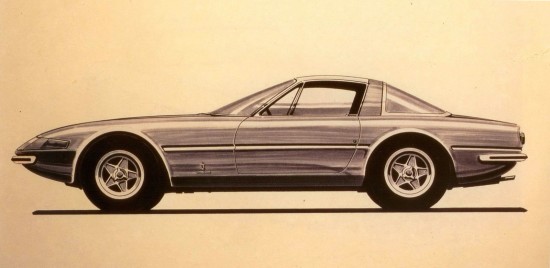
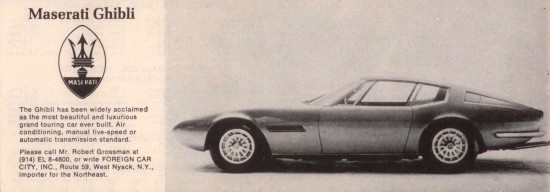
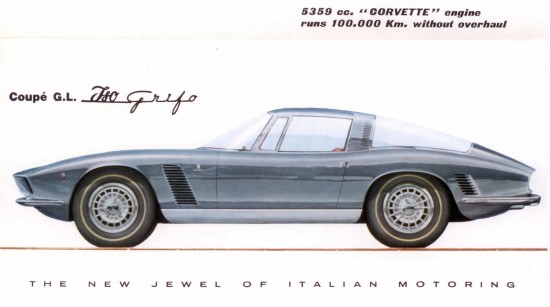
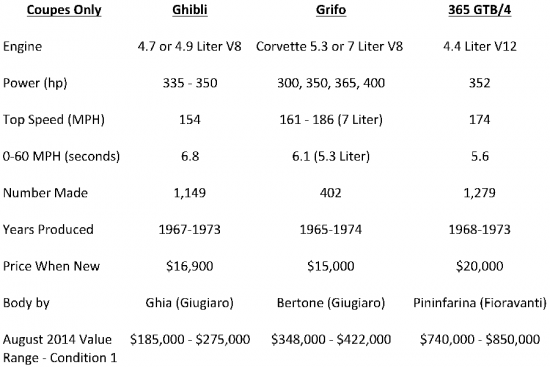
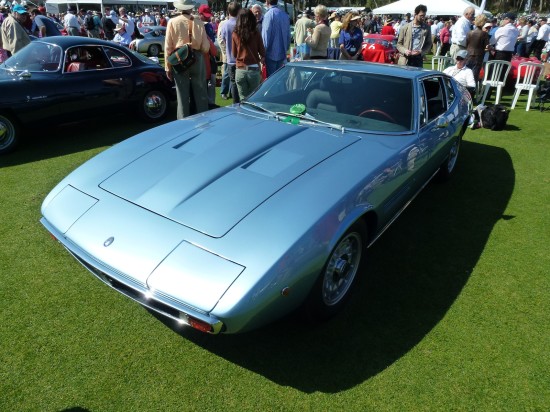

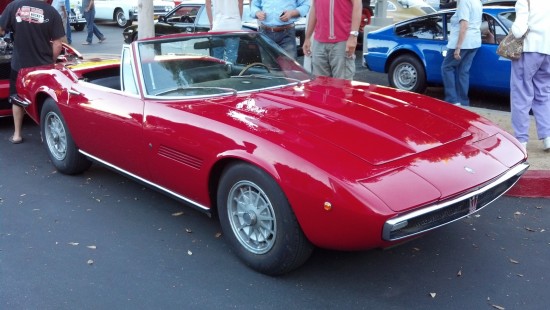
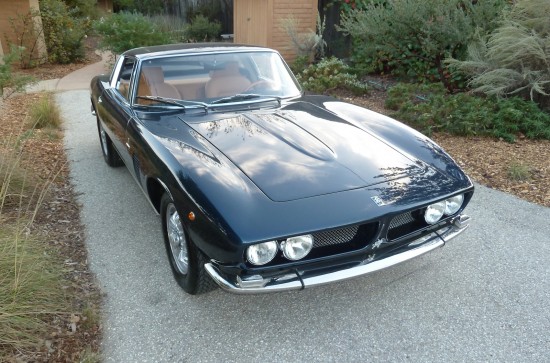
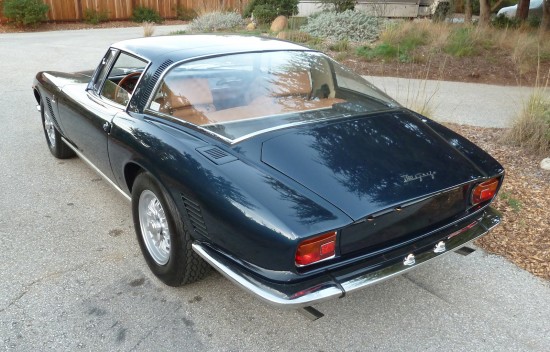
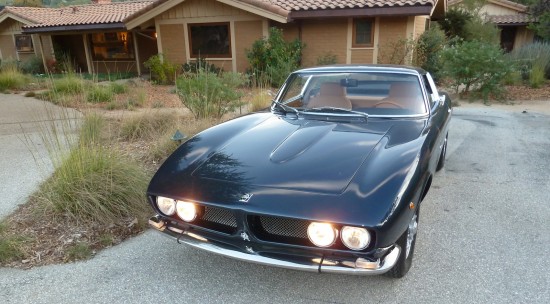
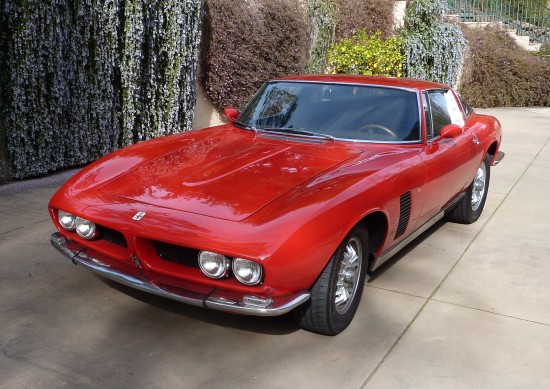
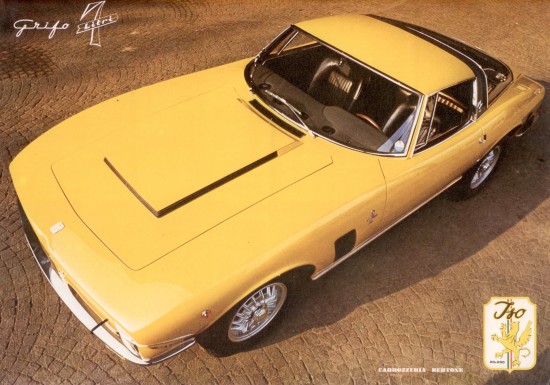
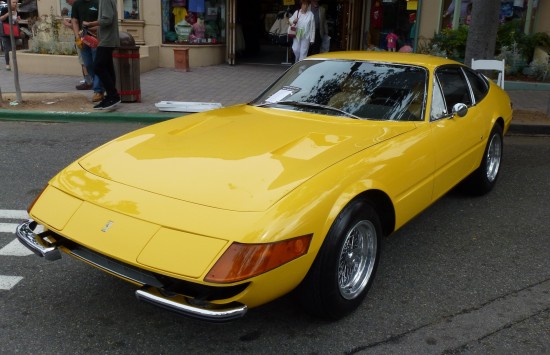
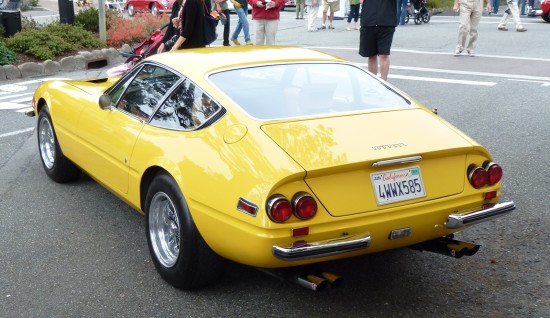

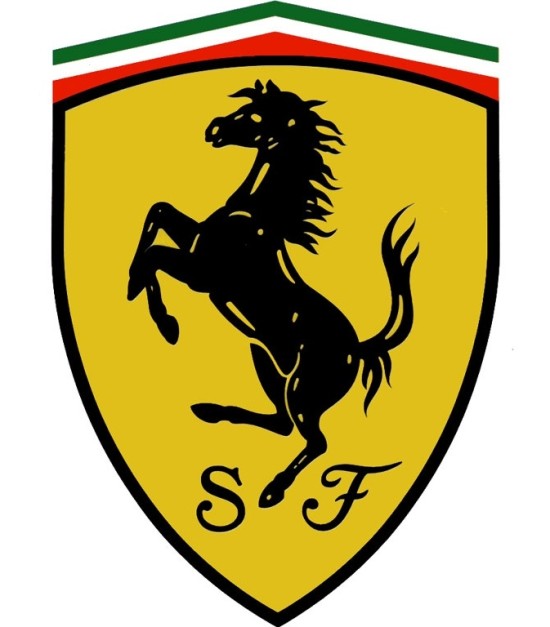
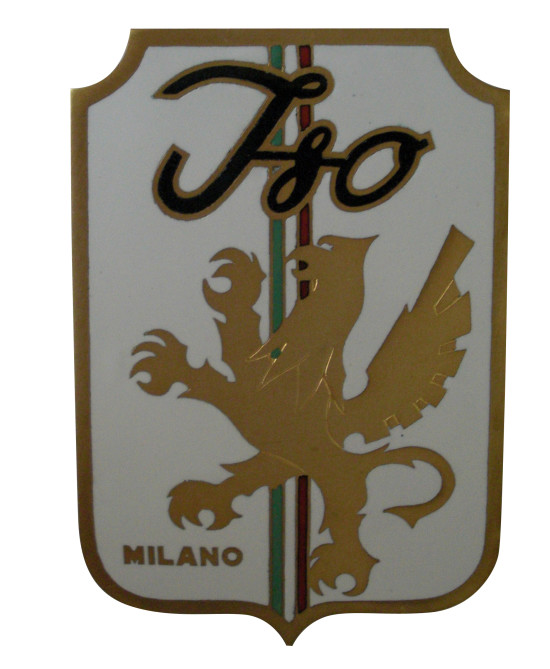
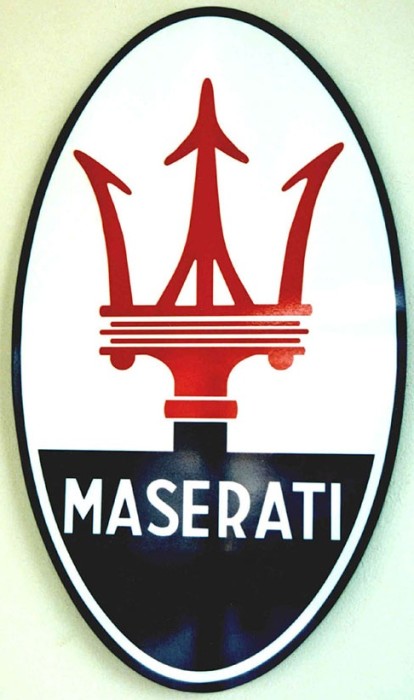



It should be pointed out that the factory’s claim of 186mph for the Grifo 7-Litre was wildly optimistic – simply wishful thinking! A 7-Litre in standard form with the 4 speed would top out at about 155mph, as suggested in the CAR article. Top speed was limited by the low rev-limit of 5200rpm (later 5400rpm) whereas the 365hp small block could rev to 6200rpm. Of course, the 7-Litre would likely get to the top speed a bit quicker due to its 460 ft lb of torque. It would take a 5 speed and the usual 3.31 axle for the 7-Litre to crack 160mph (165mph at 5496rpm, not allowing for tyre growth, by my reckoning). It could achieve a bit more with a 3.07 axle, and even more with a 2.88, but the acceleration would be correspondingly slower. If you can up the rev limit a little with a quality rotating assembly, a good cam and valve springs, then 170+mph is easily achievable. 6000rpm with the 4 speed and 2.88 is exactly 170mph, and with the 5 speed and 3.31 it’s 175mph at 5830rpm.
Interestingly, in the UK in 1968 a Grifo 7L would set you back £8,700, a bit more than a Daytona, but not quite as much as a Ghibli!
Chris,
Thanks for the lesson. You don’t think Piero tested a 7-Litre up to 186 MPH? He told me he liked to drive fast!
For me the Ghibli represents the best of these three cars. Like the Grifo, it has a beautiful Giugiaro designed body, although I think the Grifo gets the notch on the best design of the three. The let down on the Grifo is the engine. Sure, the American lump is powerful and reliable but it does not sing … it yells. For people that like muscle cars that is no problem but an Italian car is all about the senses. The Daytona on the other hand has a wonderful engine but the overall package is a car that feels heavy in city driving and will beat you up on a long drive.
The Ghibli,with the optional power steering is easy to drive and has plenty of power from an engine you can immediately sense came from Italy. Take it on a long trip and the car will reward you, but it will also feels at home in city driving.
Ivan,
Spoken like a true Maserati guy!
As for your statement “the let down on the Grifo is the engine”, I think while Maserati and Ferrari owners are waiting for work to be done, and likely waiting for parts, the Grifo owners are out driving! Unless it is raining, I don’t drive my Grifo in the rain.
“The let down on the Grifo is the engine”
Go figure…..Ironic as Eng Bizzarrinni is on tape claiming it is it’s (A3/C) strength!
But I think Eng B. strength as an engineer is his adherence to the discipline that quality is conformance to requirements..
Great article Mike.
I also have a Ghibli and really love it, but have been looking at either a Grifo or a Daytona lately.
Love the Grifo’s American power and reliability, and the Daytonas style and sound.
Mike K. – you could buy two Grifos for the price of one GTB/4. But what’s money for? you can’t drive it!
“you can’t drive it!”
plenty of room in the trunk for it.
You forgot the De Tomaso Mangusta of the same era . I owned one of the four RHD ones bought into Australia . It was 10 years old at the time and had the 302 Ford V8 changed for a 351 . Great car in a straight line , let down by Italian electrics .
Wayne,
The Mangusta is another masterpiece by Giugiaro, IMO. I did not include it in this comparison because it is so different than the three front engine comfortable GT cars that I wrote about. The Mangusta gets a lot of my attention on My Car Quest, however.
You are correct Mike as I am 6 feet tall and just fitted in with the windscreen almost touching my forehead , the back of my head resting against the rear screen and my body all scrunched up . Perfect rear design for Australia though as when you lifted both gull winged engine lids on the rear the battery was on one side and a 24 pack of beer perfectly slotted into the other side as though the designers had that in mind . Loved when I was stopped at lights , you could see people mouthing Ferrari …….. it was red and was Italian , so who cared . I paid $8000 and sold it for $18000 eventually and thought I was king of the world . Wonder what it is worth now !!
In the realm of that +150MPH, heaven is a likely destination one might be rushing to in any of these great cars.
For perspective I will add to the comparison metrics a bit more granulation on their relative attributes
Curb wght kgs (lbs)
Daytona: 1,200kg (2,614)
Iso Grifo: 1,436-1610 (3,150-3550)
Ghibli 1,650-1,770 (3640-3,900)
Then
lb/hp
Daytona 7.42 (2,614/352)
Iso Grifo: 8.88 (3,550/400)
Ghibli: 11.14 (3,900/350)
(Grifo and Ghibli, heaviest weight/highest HP)
optimader,
I like the additional parameters you have suggested: weight and weight to power ratio.
Your weight for the Ferrari seems very low. I checked Wikipedia and that is what they say but my book says 3,530 lbs which seems about right. Maybe Wikipedia was referring to the alloy body version?
The same book has the Grifo at 3,036 lbs and the Ghibli at 3,745 lbs.
btw, Wikipedia as the reference of convenience for curb wght
I think you might be looking at this too mathematically. Drive and live with each one of these cars for an extended period of time and you will get to really know what they are all about. All three are great cars in their own unique way, but as I said before my personal preference is the Ghibli, and I am sure other people will have theirs.
I love my Grifo, so please do not send the towns people with their torches to burn my house.
Just the other day, a friend who once used a Grifo as his everyday car emailed me, and said he tried both the Grifo and Ghibli before he settled on the Grifo. He just thought the Grifo was a nicer drive, the Ghibli feeling a little bit truck-like. As they both share the same front suspension, I guess it boils down to the difference between a well-located coil-sprung deDion rear end on the Grifo and the old-fashioned cart springs with live axle on the Ghibli. There was once a very interesting back-to-back comparison in Griffon years ago where Winston pitted a Grifo and a 4.7 Ghibli back to back. On performance the Grifo won every time! Don’t get me wrong, I love Ghiblis too and I think they are still undervalued, though I heard of one sold by a London dealer to Switzerland recently for £170K. Maybe their time has come?
Out of 10 magazine road tests of the Grifo, quoted weight varied between 2800lb and 3515lb. Most were around the 3200lb mark, however. The 7L was 3578lb in Deutsche Auto Zeitung (converted from Kg).
Some people criticize the 7L for its extra weight over the smallblock, but in fact, the latter has a slight rearward weight bias in standard form and the 7L is almost exactly equal front to rear. I can attest to the excellent balance of the chassis as many years ago I was driving my 7L round Silverstone, and the red mist came down, I had to pass everything on the start/finish straight with the result the I arrived at Copse at about the same speed as Grand Prix cars took that corner… Needless to say, the laws of physics prevailed and we just slid sideways straight off into the gravel trap – no spin! The marshall who came to pull me out with a Landrover said “don’t you just feel a prat when you do that !” I had to let both tyres down on one side of the car to get all the stones out from between the tires and the rims… I was still finding gravel years later. Learnt my lesson though – first find out where the track goes before trying any heroics!
Really great article Mike because the 3 cars are genuinely comparable then and now.
As for values, the ‘brand’ will always add a premium over the actual metal.
Ferrari and Maserati are way up there as brands, with Maserati gaining ground rapidly as Ferraris become ‘unaffordable.’
You and others have done a great job establishing ‘Iso’ and ‘Grifo’ as brands but mass market engines will never hold the same appeal to investors, however well they perform. Their real value is in the joy they give to an owner who wants to drive without being caned on running costs. If we could put a price on ‘cost per mile’ the comparisons would be different.
Paul,
Thank you for the comments. However, your statement “mass market engines will never hold the same appeal to investors” would be argued by owners of Shelby Cobras with their Ford engines.
I owned both a Grifo and a Ghibli at the same time and ended up keeping the Grifo. It was easier to drive and I loved the looks. The Ghibli was much more work on the maintenance side, but you knew you were driving something special every time you got behind the wheel. The engine sound was wonderful and it was the type of car that made you always want to press the accelerator pedal a little further for more of that engines music.
Interesting piece, I’ve never been fortunate enough to experience a Ghibli, but I own a Daytona and my Dad owned a Grifo until recently (the one sold at the Goodwood FOS sale). IMO the Grifo feels like an older design than the Daytona with a narrower cockpit, and one of the Daytona’s predecessors the Ferrari 330/365 GTC might be a closer comparison to the GL300 version that my Dad had?
There was no point in performance comparisons as that particular Grifo was an automatic and the Daytona is clearly a much faster car. The Daytona’s also felt iike it had the better suspension setup and was less unsettled by the poor UK roads than the Grifo although there was not a lot in it. Biggest surprise with the Grifo is that is has a worse turning circle than the Daytona which I didn’t thing was possible.
As to the point above about Daytona weight the 1200kg was the weight originally quoted by Ferrari. It was a dry weight and is wildly optimistic. True weight is somewhere between 1500 and 1600kg depending on year. The early plexiglass cars are a little lighter and the last US spec cars with additional smog gear, thicker bumpers and side impact bars are the heaviest.